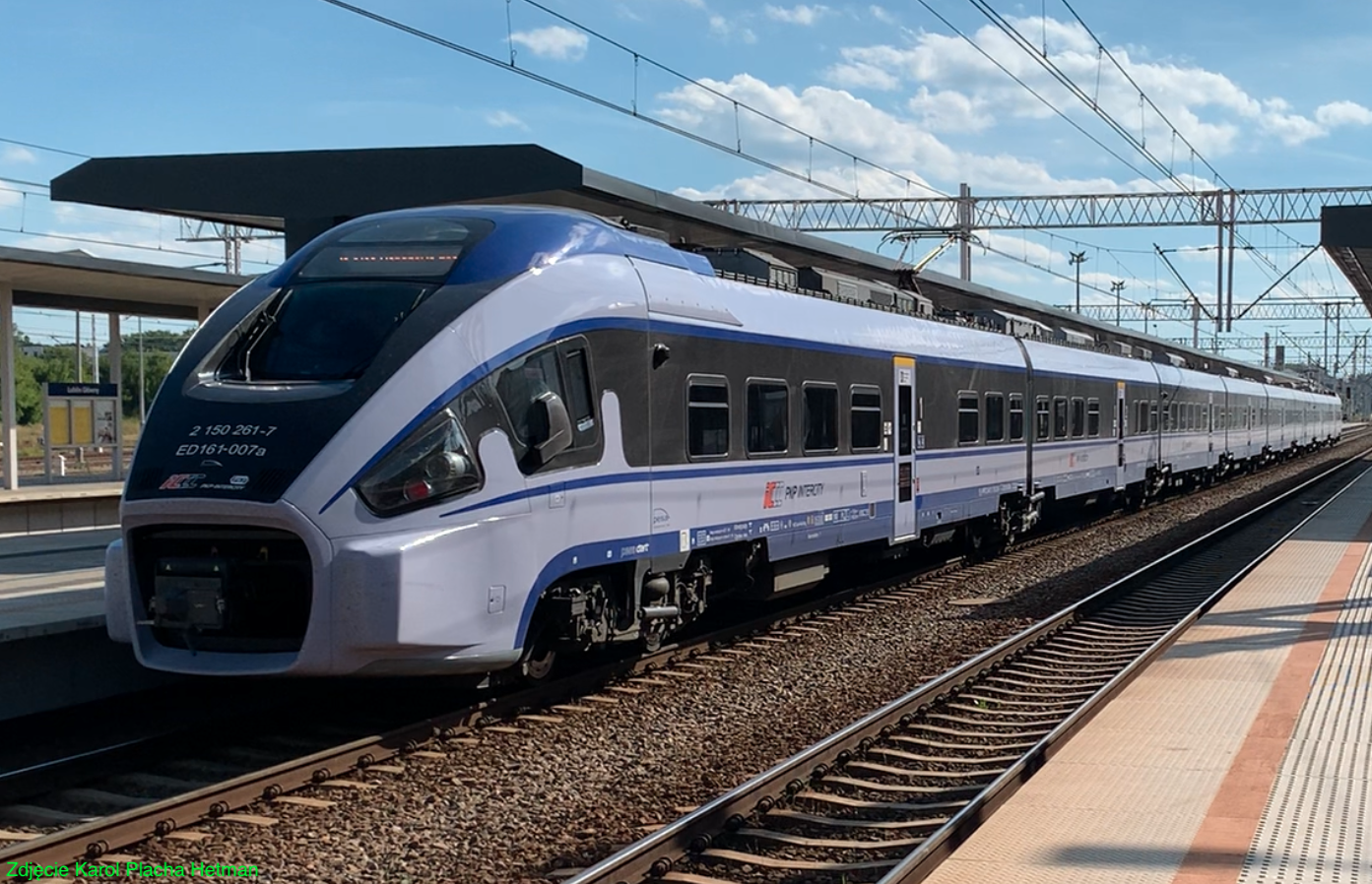Lublin 27-06-2024
EMU Pesa Dart ED161.
The Pesa Dart ED161 EMU is an Electric Multiple Unit designed and manufactured in Poland at PESA Bydgoszcz. The trains were produced between 2014 and 2016.
Pesa Dart EMU, type 43WE, ED161 series. The train is designed for long-distance passenger traffic. The train was developed and manufactured by the PESA Bydgoszcz Railway Vehicles plant. Between 2014 and 2016, 20 trainsets were produced for PKP InterCity. The ED161 EMUs were put into service on 29 December 2015, with a timetable until 31 March 2016.
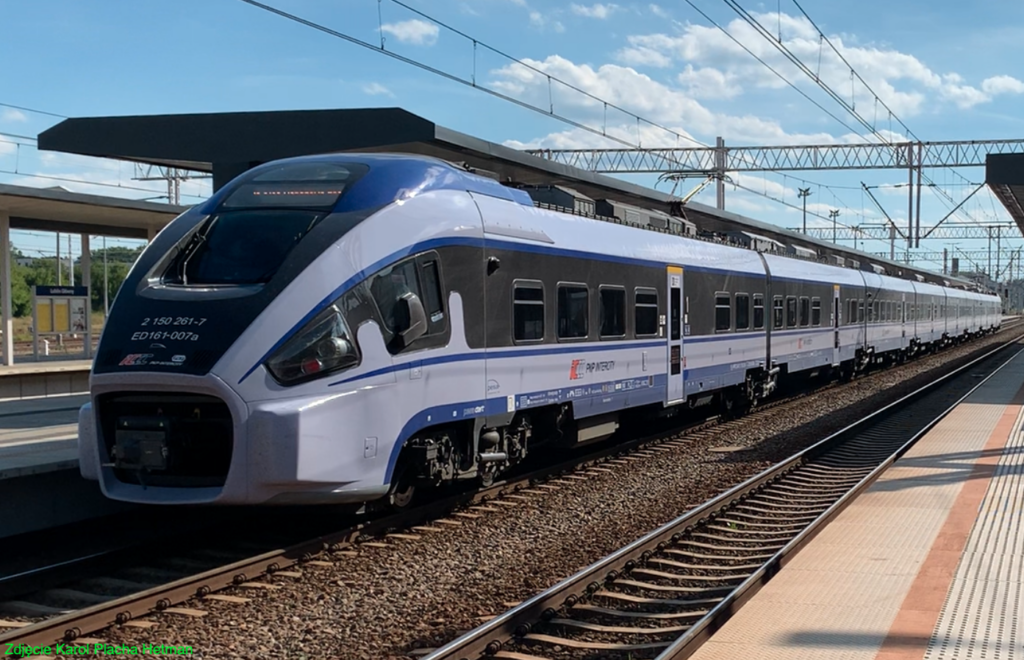
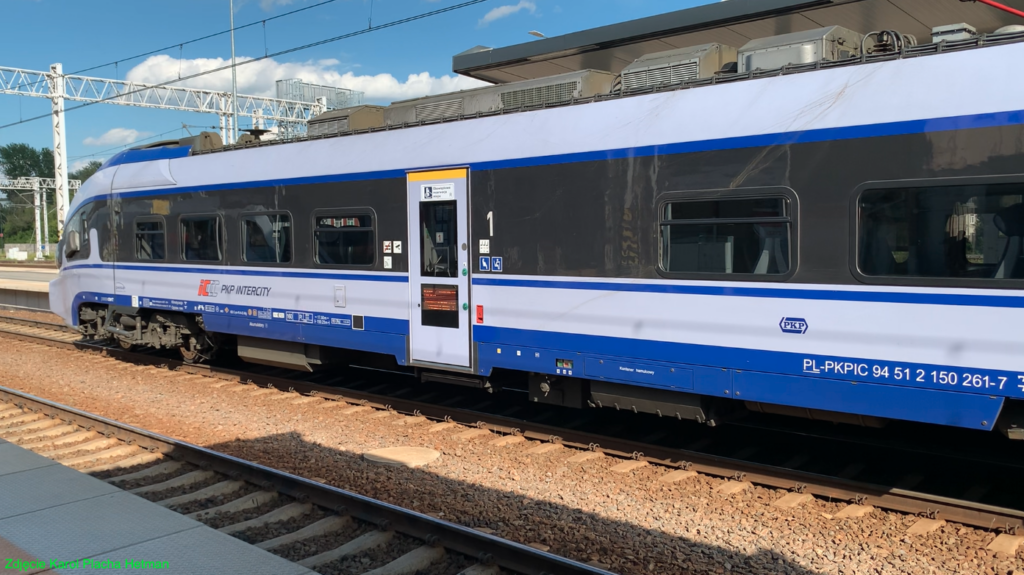
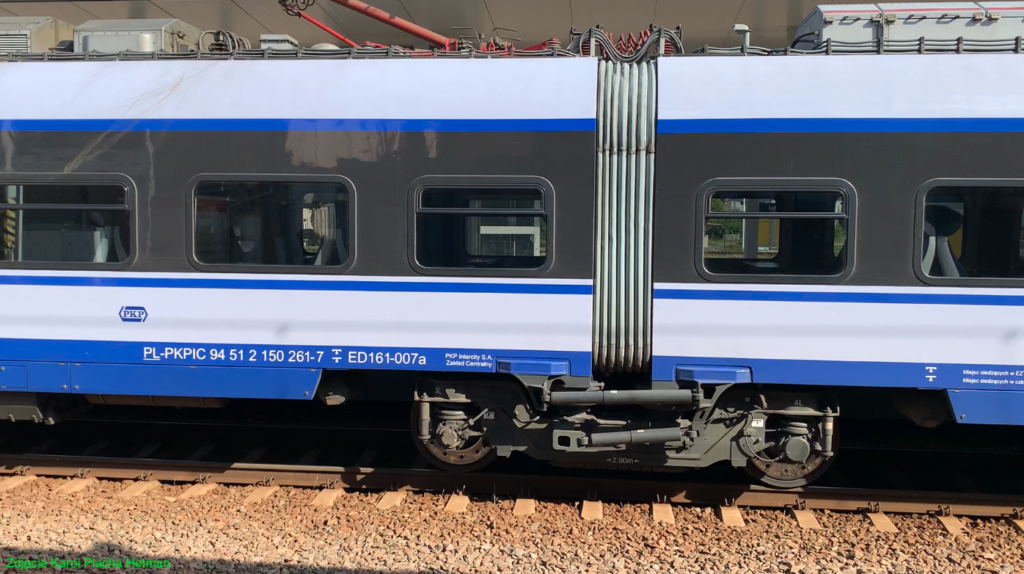
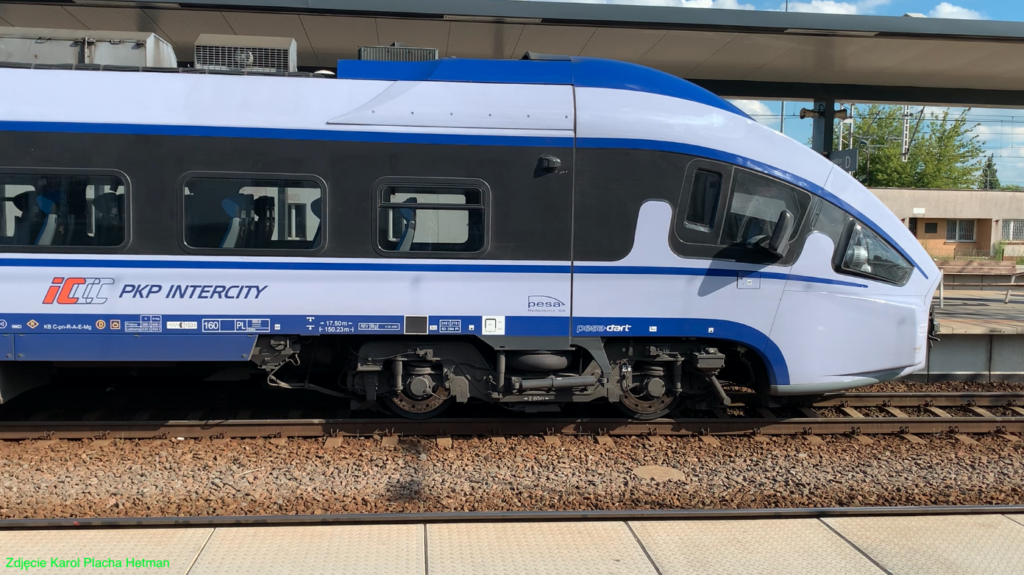
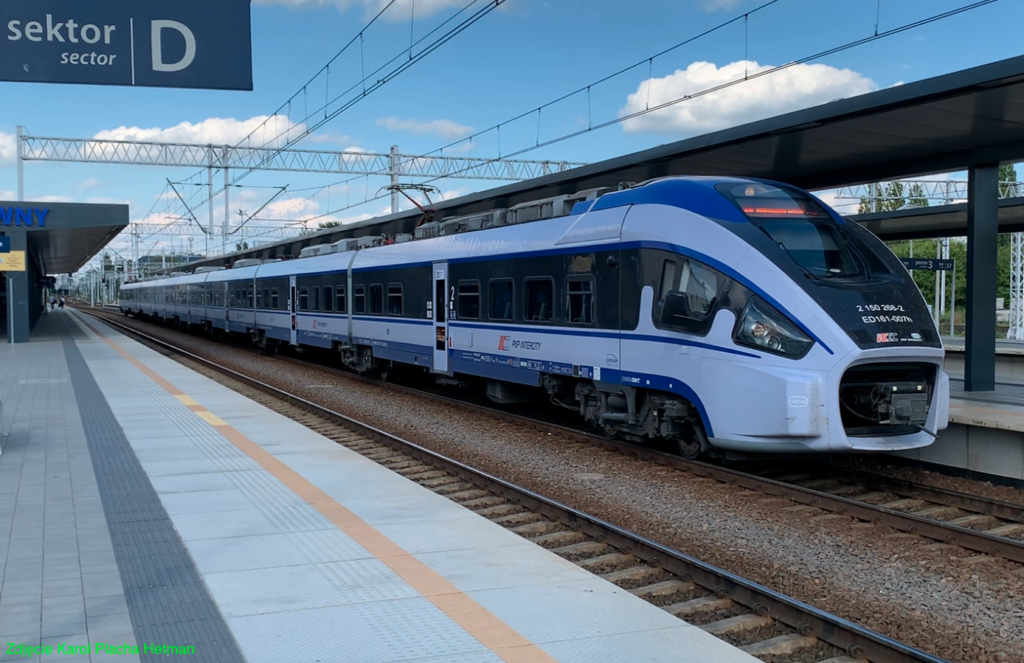
History of the ED161 EMU.
In 2004, PESA built the first EMU called Mazovia (EN95 series) for the Warsaw Commuter Railway. In the following years, PESA gradually increased the range of EZT vehicles it offered. Trains built included the Acatus series ED59 (2005,) and the Bydgostia series ED74 (2007). In 2010, the first Elf series 4-car train was built. This was followed by Elf 2-, 3-, 4- and 6-car trains. These were trains for regional services. There was also a project for an Elf train of 8-carriages, which was offered for long-distance traffic for PKP Intercity. Ultimately, PESA offered a new Dart-series EZT train in the tender.
In April 2014, the National Centre for Research and Development awarded PESA a grant of PLN 7 million for the development of the Dart train prototype. On 23 May 2014, PKP InterCity signed a contract with PESA for the supply and 15-year service of 20 ED161 Dart series trains.
The first ED161 Dart train was completed on 10 May 2015. Tests were started on routes around Bydgoszcz. During these tests, the ED161 EZT on the Bydgoszcz – Warlubie section reached the target maximum speed of 160 km/h. From 23 May 2015, homologation tests began at the Railway Institute in Żmigród.
On 30 May 2015, the ED161 train on the Central Railway Line reached a speed of 204 km/h. On 18 June 2015, the train was presented to journalists in Żmigród. On 5 July 2015, testing of the second trainset began. In September 2015, PESA submitted an application to the Railway Transport Authority, for the train to be authorised for operation. On 22 September 2015, the ED161-004 train was presented at Trako. Later, the train was presented at stations in Lublin, Dęblin and Bydgoszcz.
As there were also foreign companies competing in the tender for PKP InterCity, people started looking for inconsistencies between the actual train and the tender. It was invented that the weight of the train did not correspond to the assumptions and that the construction of the first vehicle was completely different from the subsequent trainsets being built. Fortunately, all allegations were refuted. Let us remember that there are many forces in Poland that wish our nation the worst; communists, Volksdeutsche, Freemasons. The first Dart ED161 train was authorised for operation as planned on 30 October 2015.
On 2 December 2015, the Railway Transport Authority authorised 8 ED161 trains to enter service. By the end of December 2015, PESA had built all the trains. All that remained was to receive them, rectify defects and put them into service. On 5 March 2016, PKP InterCity took delivery of the last 20 EMUs of the ED161 series.
There was the issue of penalties being charged for not handing over the trains on time. The matter was settled in arbitration, the negotiations of which were covered by secrecy. It is estimated that the penalty could amount to PLN 50-70 million, which would exceed the price of one train.
In November 2016, EZT ED161-020 successfully passed the ETCS Level 2 certification tests, which were carried out on the Miłkowice – Chojnów section of the No 282 line on the E 30 route.
On 23 May 2017, the three-year period in which PKP InterCity could place an order for an additional 10 trains of the ED161 series passed, which the carrier did not do. However, in 2023, there was again talk of more ED161 trainsets.
In September 2015, the construction of a hall for the ED161 Dart EMU service on the premises of ZNTK “Minsk Mazowiecki” was completed. ED161 Dart trains serve routes from Warsaw to; Łódź, Wrocław, Bielsko Biała, Wałbrzych, Jelenia Góra, Katowice, Lublin, Białystok, Biała Podlaska, Chełm.
During the first month of operation, ED161 EMUs made 247 journeys, during which they covered more than 69,000 km and carried nearly 45,000 passengers. In the first three years of service, ED161 Dart vehicles carried 11.5 million passengers and covered 13.2 million km.
On 14 April 2017, EZT ED161-020 was damaged on the Krotoszyn – Zduny route of line No. 281, as a result of running over a track with a missing rail fragment. Negotiations between the carrier and the manufacturer took a long time. The vehicle returned to service in December 2022.
On 30 January 2020, there was an accident on EMU ED161-016, as a result of which the front of the train was severely damaged. The collision took place on the Ozimek – Chrząstowice route, at a level crossing in Nowa Schodnia, which was unauthorisedly entered by a truck. Unfortunately, the truck driver was killed. The lorry with a semi-trailer had driven under the PKP InterCity IC Panorama 1620 Warsaw-Wrocław train. As the repair was complicated, the repair was contracted to the manufacturer PESA. The value of the contracts included in the repair order amounted to PLN 12.6 million. PESA had 20 months to carry out the repair, which took much less time.
Construction of the ED161 Dart.
The self-supporting body is made of high-grade steel, aluminium alloys and some cladding components are made of composites. The carriages comply with EN 15227 standards, i.e. four crash scenarios. Driver’s cabs have been placed at both ends of the depot, which are built into safety cages. Aluminium in a honeycomb structure provides an absorber for crash energy.
Automatic Scharfenberg-type couplers have been placed in the front of the train. Initially, the couplers were covered with aerodynamic covers, which were pulled down manually. But by the time the first trainset was handed over to the customer, this solution had been abandoned and a frame was used, which partially exposes the coupling.
The EMU consists of eight coaches. Each wagon has one pair of entrance doors, located near the centre of the wagon, single-winged, automatically opening, bump-and-slide. The entrance clearance is 0.90 m. The entrance threshold is at a height of 0.76 m from the rail head. The floor of the passenger area is at one height, or 1.22 m.
The interior of the wagons is compartmentless. Only partition walls are used at the ends of the carriages and in the entrance corridors. All partitions are equipped with automatically opening glass doors. Half of the seats are arranged in one direction and the other half in the other direction. In Class 1, the seats are arranged in a 1×2 arrangement, and all seats have access to tables. In the Class 2, the seats are arranged in a 2 (forward) x 2 (rearward) arrangement. Germanic seats from Kiel have been fitted, which have an adjustable backrest, folding tables, a newspaper net and a footrest. The aisle is the middle of the carriage. There are six toilets in the depot, one of which is for the disabled. All toilets are in a closed system. There is a bar area in the depot and a railway staff area with a bed and toilet with shower. There are lifts and wheelchair spaces for the disabled. Space for six bicycles is provided inside the depot. The depot is air-conditioned, equipped with electrical sockets, monitoring and an electronic passenger information system. There is also wi-fi.
The ED161 Dart is seated on nine bogies. The outermost bogie type 39MN is a drive bogie. Also the third bogie of the Jakobs type 40 MN is a drive bogie. The remaining bogies of the Jakobs type 40MNT are rolling bogies. The drive is provided by 6 traction motors of 6 x 400 kW, giving a total unit power of 2,400 kW. The trainsets are designed for speeds of 160 km/hr and were certified as such. But the manufacturer has developed trainsets for a travelling speed of 230 km/h, which would use more powerful traction motors, possibly more drive bogies and more powerful inverters. The inverters are located on the roof of the vehicle. The EZT Dart can be combined into two trainsets.
Data T-T EMU PESA Dart ED161:
Manufacturer PESA Bydgoszcz Poland. Production period 2014-2016 The train is an 8-car train. Bo’2’Bo’2’2’2’2’2’Bo’ axle arrangement. Service weight 395,000 kg. Length 150.23 m. Width 2.82 m. Height 4.30 m. Diameter of wheels 0.92 m. 3 kV DC power supply. Asynchronous drive motors, 6 x 400 kW. Continuous power 2 400 kW. Starting acceleration 0,6 m/s2. Design speed 200 km/h. Service speed 160 km/h. The height of the entry threshold is 0.76 m from the railhead. Number of seats in Class 1 – 60, in Class 2 – 294.
Written by Karol Placha Hetman
